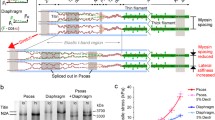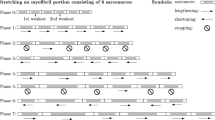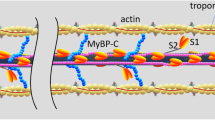Summary
Electron micrographs and optical diffraction patterns of the Z-band were studied in rat soleus muscle fixed before, during, and after tetanic contraction. We compared the morphology (small square or basketweave pattern) and dimensions of the Z-lattice of control and tetanized muscles near rest length. Z-bands of muscle fixed at rest and of muscle allowed to rest after a tetanic contraction exhibited the small square pattern. Z-bands from muscle fixed during tetanic contraction exhibited the basketweave pattern. Concomitant with the transition to basketweave, we observed an average increase of 20% in spacing between the axial filaments of the Z-lattice. Optical diffraction measurements of the A-bandd 10 spacing revealed that the Z/A ratio remained constant during the transition. We have modelled the small square to basketweave transformation as resulting from a change of curvature of constant length cross-connecting Z-filaments when the axial filaments increase their separation.
Similar content being viewed by others
References
Caspar, D. L. D., Cohen, C. &Longley, W. (1969) Tropomyosin: Crystal structure, polymorphism, and molecular interactions.J. molec. Biol. 41, 87–107.
Davey, D. F. (1976) The relation between Z-disk lattice spacing and sarcomere length in sartorius muscle fibers fromHyla cerulea.Aust. J. exp. Biol. Med. Sci. 54, 441–7.
Elliott, G. F., Lowy, J. &Millman, B. M. (1967) Low-angle X-ray diffraction studies of living striated muscle during contraction.J. molec. Biol. 25, 31–45.
Fardeau, M. (1969a) Ultrastructure des fibres musculaires squelettiques (1).La Presse Medicale 77, 1341–4.
Fardeau, M. (1969b) Etude d'une nouvelle observation de ‘Nemaline Myopathy’. II. Donnees Ultrastructurales.Acta neuropath. 13, 250–66.
Franzini-Armstrong, C. (1973) The structure of a simple Z line.J. Cell Biol. 58, 630–42.
Goldstein, M. A., Schroeter, J. P. &Sass, R. L. (1977) Optical diffraction of the Z lattice in canine cardiac muscle.J. Cell Biol. 75, 818–36.
Goldstein, M. A., Schroeter, J. P. &Sass, R. L. (1979) The Z lattice in canine cardiac muscle.J. Cell Biol. 83, 187–204.
Goldstein, M. A., Stromer, M. H., Schroeter, J. P. &Sass, R. L. (1980) Optical reconstruction of nemaline rods.Exp. Neurol. 70, 83–97.
Goldstein, M. A., Schroeter, J. P. &Sass, R. L. (1982) The Z-band lattice in a slow skeletal muscle.J. Musc. Res. Cell Motility 3, 333–48.
Kelly, D. E. (1967) Models of muscle Z-band fine structure based on a loo** filament configuration.J. Cell Biol. 34, 827–40.
Kelly, D. E. &Cahill, M. A. (1972) Filamentous and matrix components of skeletal muscle Z disks.Anat. Rec. 172, 623–42.
Knappeis, G. G. &Carlsen, F. (1962) The ultrastructure of the Z disc in skeletal muscle.J. Cell Biol. 13, 323–35.
Landon, D. N. (1970a) The influence of fixation upon the fine structure of the Z disc of rat striated muscle.J. Cell Sci. 6, 257–76.
Landon, D. N. (1970b) Change in Z-disc structure with muscular contraction.J. Physiol., Lond. 211, 44–45.
MacDonald, R. D. &Engel, A. G. (1971) Observations on organization of Z disc components and on rod-bodies of Z disc origin.J. Cell Biol. 48, 431–6.
Magid, A. &Reedy, M. K. (1980) X-ray diffraction observations of chemically skinned frog skeletal muscle processed by an improved method.Biophys. J. 30, 27–40.
Podlubnaya, Z. A., Tskhovrebove, L. A., ZaalishiVili, M. M. &Stefanenko, G. A. (1975) Electron microscopic study of alpha-actinin.J. molec. Biol. 95, 85–90.
Reedy, M. K. (1964) The structure of actin filaments and the origin of the axial periodicity in the I substance of vertebrate striated muscle.Proc. R. Soc. Ser. B. 160, 458–60.
Schroeter, J. P., Goldstein, M. A. &Sass, R. L. (1983) Modeling filamentous structures of the Z band using DRAW3D.Proc. 11th Annual PROPHET User's Colloqium, Airlie, Virginia.
Yamaguchi, M., Izumimoto, M., Robson, R. M. &Stromer, M. H. (1985) Fine structure of wide and narrow vertebrate muscle Z lines.J. molec. Biol. 184, 621–44.
Yu, L. C., Lymn, R. W. &Podolsky, R. J. (1977) Characterization of a non-indexible equatorial X-ray reflection from frog sartorious muscle.J. molec. Biol. 115, 455–64.
Zappe, H. A. &Maeda, Y. (1985) X-ray diffraction study of fast and slow mammalian skeletal muscle in the live relaxed state.J. molec. Biol. 185, 211–14.
Author information
Authors and Affiliations
Rights and permissions
About this article
Cite this article
Goldstein, M.A., Michael, L.H., Schroeter, J.P. et al. The Z-band lattice in skeletal muscle before, during and after tetanic contraction. J Muscle Res Cell Motil 7, 527–536 (1986). https://doi.org/10.1007/BF01753569
Received:
Revised:
Issue Date:
DOI: https://doi.org/10.1007/BF01753569




